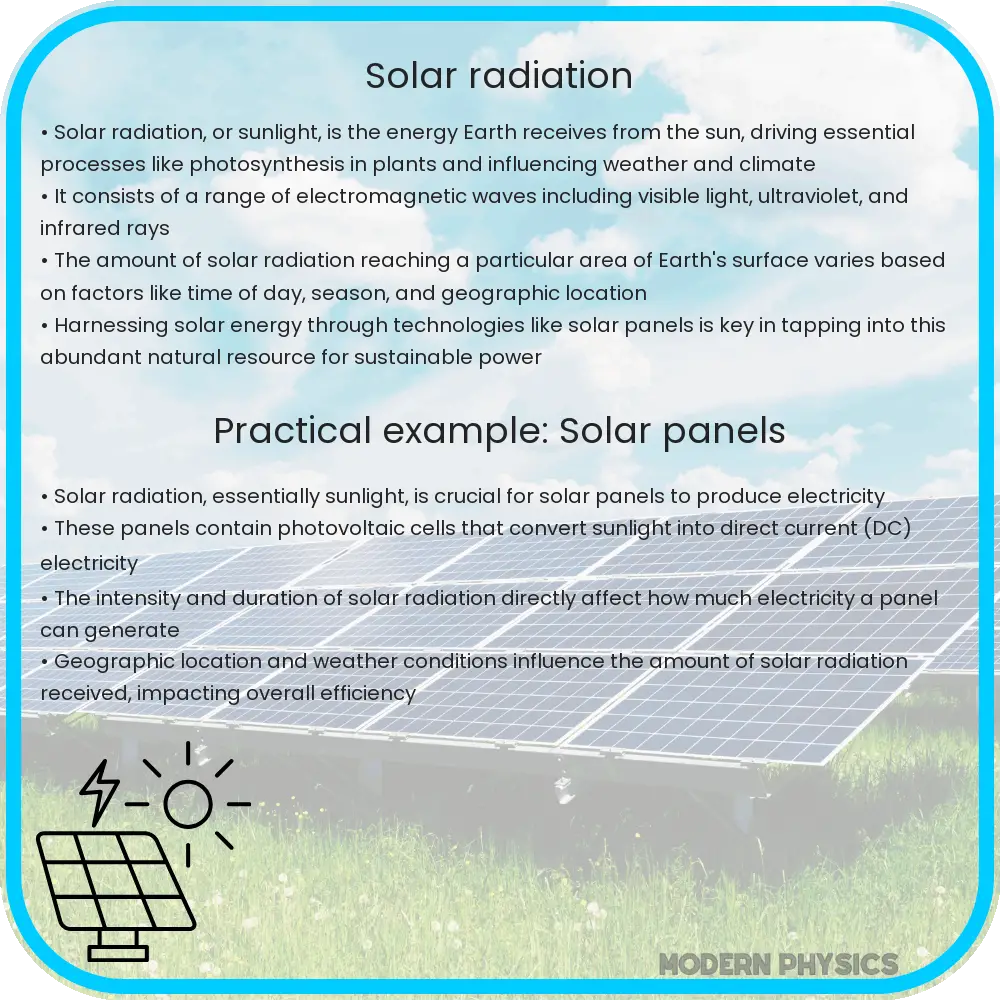Solar radiation refers to the electromagnetic energy emitted by the sun, impacting climate, photosynthesis, and solar power.

Understanding Solar Radiation: An Overview
Solar radiation refers to the electromagnetic energy emitted by the sun. It is a fundamental driver of many processes on Earth, including climate and weather systems, photosynthesis in plants, and solar power generation. The interaction of solar radiation with the Earth’s atmosphere significantly shapes the planet’s environmental conditions.
The Atmospheric Impact of Solar Radiation
Once solar radiation reaches the Earth, it interacts with the atmosphere in complex ways. Some of the radiation is absorbed by atmospheric gases, while some is scattered back into space, and the rest penetrates the atmosphere, reaching the Earth’s surface. The proportion of absorbed versus reflected radiation has critical implications for the Earth’s heat balance and climate.
- Absorption: Gases such as ozone, water vapor, and carbon dioxide absorb specific wavelengths of solar radiation. Ozone, for example, absorbs the harmful ultraviolet (UV) radiation, providing a natural shield that protects life forms on Earth.
- Scattering: Scattering occurs when particles and gases in the atmosphere deflect solar radiation, changing its path. This phenomenon is responsible for the Earth’s albedo effect, which influences the planet’s energy balance. Rayleigh scattering, which is more effective at shorter wavelengths, is why the sky appears blue on a clear day.
- Reflection: Some surfaces, particularly those that are light-colored and bright, like ice and snow, have high albedo, meaning they reflect most of the solar radiation that hits them back into space. This reflection can affect local and global temperatures.
Modeling Solar Radiation
Understanding and predicting the effects of solar radiation on Earth necessitates complex modeling. These models incorporate various atmospheric factors and help scientists and researchers study scenarios such as climate change, weather forecasting, and the development of efficient solar energy systems.
- Climate Models: These models are used to understand long-term climate changes by simulating the interactions between the atmosphere, oceans, land surface, and ice. They are crucial for predicting how changes in solar radiation could affect global temperatures and weather patterns.
- Solar Power Generation Models: These models help in optimizing the orientation and efficiency of solar panels by analyzing the path and intensity of solar radiation based on geographical and temporal factors.
Trends in Solar Radiation
Solar radiation shows variability on both short and long-term scales. Recent studies have shown trends related to changes in solar output and its influence on Earth’s climate. Understanding these trends is crucial for developing mitigation strategies for climate change and enhancing the efficiency of solar energy systems.
- Solar Constant: Although the solar constant, the amount of incoming solar energy received per unit area at the top of the Earth’s atmosphere, is approximately 1361 watts per square meter, it is subject to slight variations due to the solar cycle and solar activity.
- Dimming and Brightening: Phenomena such as global dimming and brightening affect the amount of solar radiation that reaches the Earth’s surface. These can be influenced by factors such as volcanic eruptions, human-made aerosols, and changes in cloud cover.
Implications of Solar Radiation on Renewable Energy
One of the most promising uses of solar radiation is in the field of renewable energy, specifically solar power. Solar panels convert sunlight into electricity, which can be a clean alternative to fossil fuels. The efficiency of these solar systems is directly affected by the amount of solar radiation received, which varies by location, time of day, and weather conditions.
- Photovoltaic Systems: These systems use solar cells to convert sunlight directly into electricity. The performance of photovoltaic cells can be significantly impacted by the intensity and duration of solar radiation they receive.
- Concentrated Solar Power: In these systems, mirrors or lenses are used to concentrate a large area of sunlight, or solar thermal energy, onto a small area. The concentrated energy is then used as heat or converted into electrical power.
Practical Considerations for Utilizing Solar Energy
Integrating solar energy into the power grid requires careful consideration of solar radiation patterns and their predictability. Utilities and energy planners must account for the variability in solar energy production caused by changes in weather and seasonal shifts in solar radiation.
- Energy Storage: Solar energy is not constant throughout the day or the year. Energy storage systems such as batteries are crucial for buffering and providing a stable energy supply.
- Grid Integration: To maximize the benefits of solar power, it must be integrated effectively into the existing power grid, which involves managing the fluctuations in solar power generation and ensuring reliable energy distribution.
Conclusion
Solar radiation plays a pivotal role not only in natural processes such as climate and weather patterns but also holds the key to future technologies in energy generation. Its understanding and application in atmospheric science, climate modeling, and renewable energy systems are essential for the advancement of environmental solutions and sustainable practices. With continuous research and technological advancements, harnessing solar radiation more efficiently remains a critical goal for scientists and engineers worldwide. By embracing the power of the sun, humanity can step toward a greener, more sustainable future, effectively combating climate change and reducing our environmental footprint.
